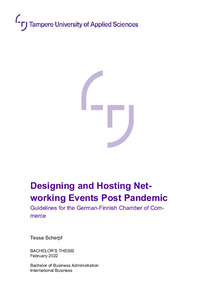Designing and hosting business networking events post pandemic : guidelines for the German-Finnish Chamber of Commerce
Scherpf, Tessa (2022)
Scherpf, Tessa
2022
All rights reserved. This publication is copyrighted. You may download, display and print it for Your own personal use. Commercial use is prohibited.
Julkaisun pysyvä osoite on
https://urn.fi/URN:NBN:fi:amk-202204155265
https://urn.fi/URN:NBN:fi:amk-202204155265
Tiivistelmä
The COVID-19 pandemic heavily disrupted business networking events and new concepts for designing and hosting them were to be identified for post pandemic times. The objective of this thesis was to deliver guidelines to the commissioning company. Its purpose was to analyse experiences deriving from online business networking events during the COVID-19 pandemic according to three key variables: technology, customer journey, and experience and engagement. One-on-one interviews of an explorative nature were conducted. Interviewed were 5 individuals from Finnish and German companies, frequently participating in business networking events pre, during, and post the COVID-19 pandemic. Primary data and secondary data, discussed in the theoretical framework, complemented each other to build new theory and suggest recommendations.
Contrary to what was assumed in previous research, interviewees preferred a face-to-face meeting to build connections rather than in a hybrid or online setting. Technology, in the form of new tools and platforms, presented a focus and interviewees expressed interest towards virtual reality, the metaverse, and physical convergence, but emphasized the need for technology being easy to use. Pain points in the customer journey were perceived to be an insufficient agenda and organisation, a feeling of being socially disconnected, and being tired of online meetings. Interviewees felt engaged most by interactive tools, and creative concepts. During online business networking events, an experience was derived from the utilisation of personalized avatars in a virtual world.
Guidelines proposed to the commissioning company include a decision matrix for the event setting depending on length and location of invited participants. It is suggested to frequently identify emerging technology and integrate these into online and hybrid events and complement face-to-face meetings alike. Event hosts are suggested to incorporate an attendee-centric mindset to eliminate pain points in the customer journey. Experience and engagement are recommended to be achieved by being more creative and integrating gamification.
Contrary to what was assumed in previous research, interviewees preferred a face-to-face meeting to build connections rather than in a hybrid or online setting. Technology, in the form of new tools and platforms, presented a focus and interviewees expressed interest towards virtual reality, the metaverse, and physical convergence, but emphasized the need for technology being easy to use. Pain points in the customer journey were perceived to be an insufficient agenda and organisation, a feeling of being socially disconnected, and being tired of online meetings. Interviewees felt engaged most by interactive tools, and creative concepts. During online business networking events, an experience was derived from the utilisation of personalized avatars in a virtual world.
Guidelines proposed to the commissioning company include a decision matrix for the event setting depending on length and location of invited participants. It is suggested to frequently identify emerging technology and integrate these into online and hybrid events and complement face-to-face meetings alike. Event hosts are suggested to incorporate an attendee-centric mindset to eliminate pain points in the customer journey. Experience and engagement are recommended to be achieved by being more creative and integrating gamification.
